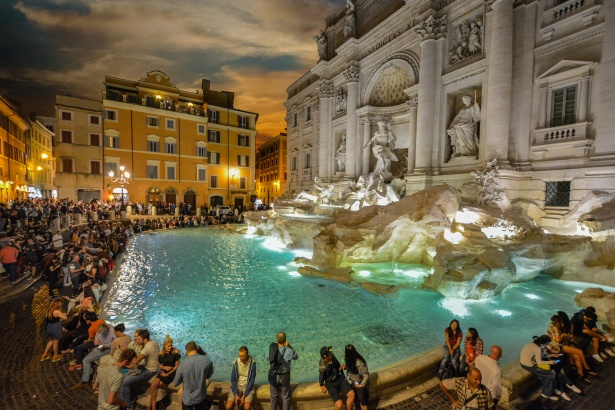
The Trevi Fountain, a timeless symbol of solidarity and mercy
The mysteries of the Trevi Fountain: Where do the coins thrown in Rome go?
One of the world’s most iconic fountains, the Trevi Fountain in Rome attracts millions of visitors every year. As well as its artistic beauty and fascinating history, the fountain is also famous for a special tradition: throwing a coin and making a wish. But what happens to all those coins thrown in by visitors? Let’s delve into the mystery to find out where these modern treasures really go.
The coin-throwing ritual
Before exploring the fate of the coins, it’s important to understand the ritual that surrounds them. Visitors to the Trevi Fountain often stand with their backs to the fountain, making a vow before throwing a coin over their right shoulder. According to tradition, throwing one coin guarantees a return to Rome, while throwing two coins ensures a romance with an Italian man or woman, and three coins would lead to marriage with that person.
Coin collection and cleaning
Every day, specially designated employees clean the fountain and collect the coins. This painstaking task often requires the use of specialised equipment to reach the coins nestling in the nooks and crannies of the fountain. The recovered coins are then meticulously sorted and cleaned. What happens to the coins afterwards is an equally captivating story.
Final destination: charity
Contrary to what some might think, the coins from the Trevi Fountain are not used for anyone’s personal benefit. In fact, these precious coins are destined for a noble cause: charity. Every year, millions of euros are collected from the waters of the fountain and then distributed to various charitable organisations, such as the Emporiums of Solidarity, which help people in need.
The role of solidarity emporiums
A Solidarity Emporium is a supermarket where people in great difficulty can buy food and basic necessities at zero cost using points cards. They also provide essential services to local communities, such as hot meals, emergency shelter and educational programmes. The idea is to offer economic support while respecting the dignity of each individual. These welcoming places allow people to feel respected even in their fragility. Since the initiative began some fifteen years ago, the Emporiums have already helped almost 40,000 people and distributed more than 5,000 tonnes of food. The Emporiums have become a place where beneficiaries can return to their usual activities, such as shopping and chatting with the many volunteers. For example, the Emporium Casilina, the first to be founded in 2008 in Rome, currently serves 100 families a day. In short, these places are a concrete example of solidarity in action, where the community pulls together to help those who need it most.
Social and economic impact
Each coin has a significant impact. The funds collected are used to support initiatives such as helping the homeless, educating disadvantaged children and preserving Rome’s cultural heritage. In this way, every coin thrown into the fountain contributes to the well-being of society and the preservation of the city’s cultural heritage.
A symbol of generosity and hope
As well as being a tourist attraction, the Trevi Fountain and the tradition of throwing coins embody a powerful symbol of generosity and hope. Visitors from all over the world who take part in this tradition in the hope of seeing their wishes come true also contribute to philanthropic causes. In this sense, the fountain becomes much more than a simple tourist attraction, but a place charged with universal meaning and values.
In conclusion, the Trevi Fountain in Rome is more than just an artistic masterpiece. Its coins make an extraordinary journey after touching the water. They find their way to charitable causes, helping to improve the lives of many individuals and providing essential support to disadvantaged communities. Simple tokens of goodwill are transformed into vital resources, making the Trevi Fountain a timeless symbol of solidarity.
